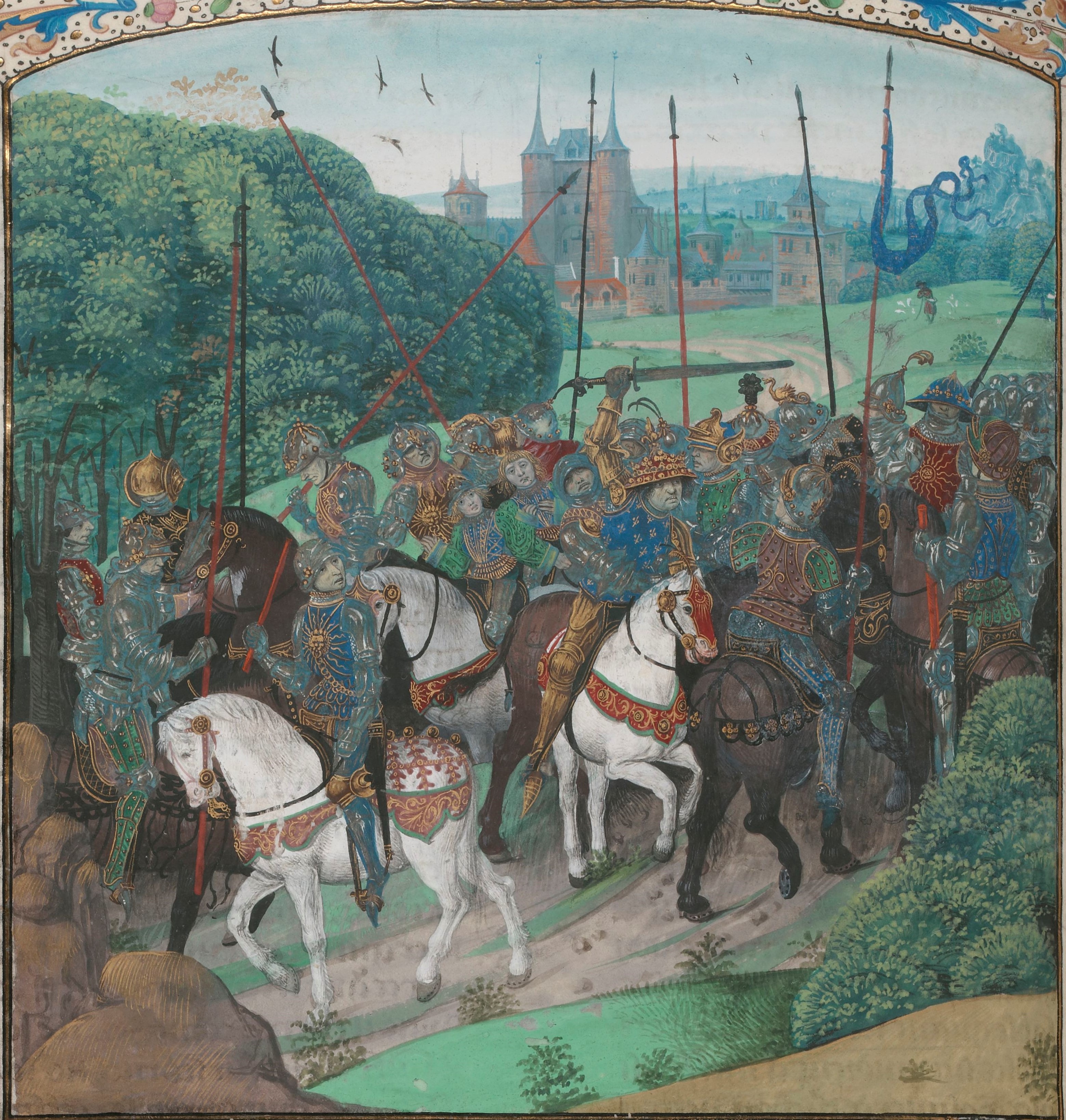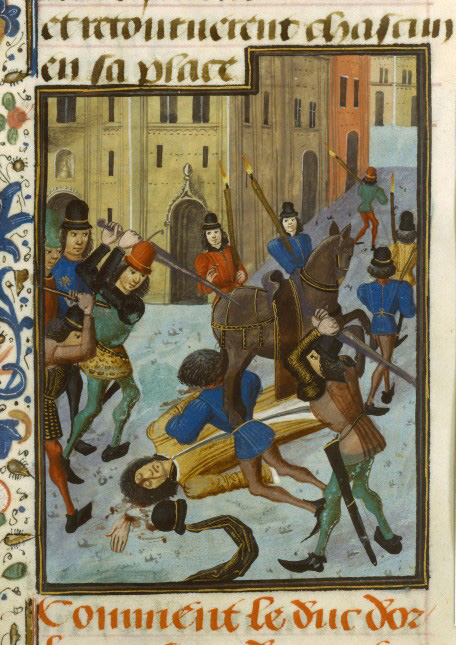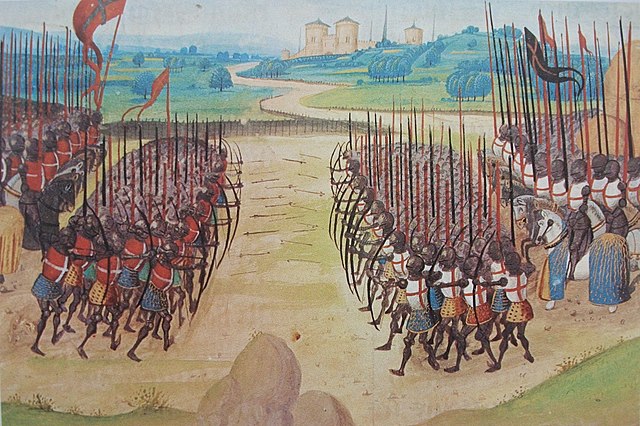Born in 1394
Charles was the grandson of Charles V of France and of Gian Galeazzo Visconti, Duke of Milan. His father was Louis, Duke of Orléans and at the time of his birth his
elder brother Louis was still alive[i]. Charles was followed by
Philip, Count of Vertus in 1396, Jean d’Angoulême[ii] born in 1400 and Margaret Countess of Vertus born in 1406.
Apart from Louis there were three other boys and two girls of the marriage who
died in childhood.
 |
| Charles VI seized by an attack of madness in the forest of le Mans |
The Duke of
Orléans was the second son of Charles V of France; his brother Charles became king in 1380. Charles VI
suffered from bouts of psychosis[iii] and eventually he became
too ill to rule and a power struggle ensued, fought between Charles VI’s uncles
and Regents, Philip, Duke of Burgundy and the Duke of Berry and Charles VI’ brother Louis. Froissart tells us that the
Duke of Burgundy told his brother;
‘Once we are in Paris, we
will assemble the whole council of France and it will be decided how the
kingdom is to be managed and who will be responsible for its administration,
whether our dear nephew of Orléans or us.’[iv]
The two
factions engaged in bitter infighting.
Charles’
mother Valentina was exiled from court, as she appeared to have some influence
over her deranged brother in-law; her husband had meanwhile possibly been
having an affair with his brother’s wife; Isabeau. Certainly the couple had been
accused of this by the Burgundian faction. According to Froissart the marriage
between the Orléans couple was not a happy one.
The marriage of Isabella to Richard II
In 1396
Charles VI’s seven year old daughter Isabella married the king of England, Richard II. But on 29th September
1399 Richard involuntarily abdicated his throne in favour of his cousin Henry, who had been exiled to France and had returned to regain
his patrimony after the death of his father John of Gaunt. Richard died in mysterious
circumstances in February 1400, despite having been promised his life. One of
Richard’s failings as far as his nobles were concerned was his peculiar
propensity for peace[v].
Assassination of Louis d’Orléans
In June 1399
Louis d’Orléans gained control of his brother’s court. The death of Burgundy in
April 1404 did not solve the power struggles between the two factions, as his
son John took on his father’s mantle,
continuing the battle with his cousin. The twelve year old Charles was married
to his cousin, the sixteen year old dowager Queen Isabella on 29th
June 1406.
The Assassination of Louis Duke of Orleans
On 23rd
November 1407 the Duke of Orléans was assassinated on the streets of Paris; a
killing to order by the young Duke of Burgundy. John confirmed his involvement,
claiming that it was a blow against tyranny, charging Louis with vice, corruption,
sorcery and a long list of other villainies.
‘He
[Duke John] employed a gang of toughs to murder his rival Louis d’Orléans in
the streets of Paris. As Louis was returning to his hotel after dark, he was
set upon by hired killers he cut off his left hand holding the reins, dragged
him from his mule, hacked him to death with swords, axes and wooden clubs, and
left his body in the gutter while his mounted escort……….fled.’[vi]
By defending
the people against yet another tax hike, John was able to appear as a protector
of the people. He had already obtained the guardianship of the Dauphin and his
siblings by what the Orléanist faction called trickery.
The funeral of the Duke of Orleans
Charles was
too young to take revenge on his father’s murderer as honour demanded, but he
was expected to take the lead of his father’s anti-Burgundian party. Charles’
mother, Valentina Visconti died on 4th December 1408
aged 40. Nine months later Isabella died in childbirth on 13th
September 1409, leaving one child Joan[vii]
The marriage of Charles to Bonne
Charles
turned to his new father-in-law, the Count of Armagnac, for support against his cousin’s machinations.
Charles second wife was the eleven year old Bonne of Armagnac, whom he married on 15th August 1410. Bonne’s
father Bernard[viii]
and he became Charles’ protector and leader of the Orléans faction[ix]. His son-in-law was
sixteen. The infighting between the factions was to consume France for the next
thirty years, seriously compromising the country’s ability to deal with the
enemy from without.
A Resurgent England
In July
1411, in the midst of his continued fight against Charles and his
father-in-law, the Duke of Burgundy sought an alliance with the English to
resist his fight with the Armagnac faction, offering four Flemish towns and assistance
in re-conquering Normandy. The decision to accept his offer was made by a
council headed by the martial Prince Henry.
Prince Henry
On 2nd
October a force from England[x] joined Burgundy at Arras,
entering Paris on 22nd in an attempt to disperse the Armagnac forces
at St Denis and St Cloud, cutting off supply lines to the city. Following
further successes with the Burgundians the English retired to Calais. Duke John
was angling for further assistance when an embassy from the Dukes of Berry,
Bourbon and Orléans, backed by Armagnac arrived in England in early February
1412.
The king’s
council was now headed by his brother Thomas, Duke of Clarence. Henry had been annoyed by
suggestions that he should abdicate in favour of his eldest son. Acceptance of
the Armagnac offer was an easy choice when Duke John announced that Charles VI
had given him the task of driving the English out of Aquitaine. The agreement
of Bourges was made between the English and the Armagnacs[xi].
Charles VI
had a copy of the agreement by 6th April with evidence of the Armagnac
treachery made plain. He informed the dukes that their conspiracy had been
uncovered and called upon them to revoke the alliance, which they did on 22nd
July. Clarence mounted an expedition into France and called on Charles to make
good his promises under the agreement. Failure to do so meant the invasion of
Charles duchy and the capture of Meung.
Following
further English successes the French dukes were ready to pay off the English
promising 150,000 crowns. The money was not available and a number of hostages,
including Charles’ younger brother the 13 year old Jean d’Angoulême, were sent
to England instead.In March 1413 Henry IV died. The bellicosity of the new king was far more to the liking of a country hard wired for war; Henry V was determined to regain the territories lost to France during his predecessor’s reigns.
‘Henry V took up the old war
and the threadbare claim to the French crown which had not gained in validity
by passing to him through a usurper. On the pretext of various French
perfidies, he invaded France in 1415.’[xii]
At the age
of 21 Charles’ life was to take another dramatic turn after the catastrophic
collapse of the French forces at Agincourt[xiii]. The war between France
and England, that was to become known to history as the One Hundred Year’s War, had been raging intermittently off and on since 1337[xiv]. Henry V’s martial
prowess led his troops to victory against an overwhelmingly larger force. He
had already taken Harfleur and crossed the Somme, making his way to Azincourt.
Charles sent
a contingent of 500 men and promised to follow later. His fellow dukes of Berry
and Bourbon withdrew their promises to support the Dauphin in his attempts to
stop the marauding English. Not long before the battle, as promised, Charles
joined his troops to the French army, along with the Dukes of Alençon, Bar,
Brittany, Bourbon and Berry. The Duke of Burgundy was equivocal in his support,
but some of his knights joined the French side.
Charles and
his fellow duke of Bourbon sent three heralds challenging the king of England
to fight before he reached Calais
‘They have heard that thou
intendest with thy forces to conquer the towns, castles and cities of the realm
of France and to depopulate French cities. And because of this, and for the
sake of their country and their oaths, many of our lords are assembled to defend
their rights; and they inform thee by us that before thou comest to Calais they
will meet thee to fight with thee, and to be revenged of thy conduct.’[xv]
Henry
rightly believed that his reply to the summons would result in the French
attacking the following day. Lacking an overall strategic and tactical
commander resulted in the massacre of many of the French nobility, who warred
in the same old way that had failed them in previous encounters with the
English. The various factions within the army would not cooperate with one
another and this disarray was partially responsible for the catastrophe.
Battle at Agincourt
The recently
knighted Charles was in the front line when the French army charged the smaller
English army. He was discovered by the English victors under a pile of dead
bodies; the weight of his armour resulted in him being unable to lift himself.
As one of the most senior French dukes and a member of the French royal family
Charles was taken prisoner and held for ransom[xvi].
Many of the
lesser nobility were not so lucky and were clubbed to death by order of Henry
V, determined not to risk losing the battle by having his soldiers distracted
from the fighting by taking prisoners[xvii]. Following the battle
the English army made its way to Calais and the dukes of Orléans and Bourbon
accompanied Henry V on the march.
‘The king rode with his two
captive dukes beside him, discussing the battle with them. To their enquiry
whether he was not now ready for peace he replied that nothing was nearer to
his heart. On that Orléans sent a herald to Rouen with the news – but nothing
came of it.’[xviii]
Bibliography
Louis XII –
Frederic J Baumgartner – MacMillan Press Ltd 1996
The Hundred
Years War – Alfred Burne, Folio Society 2005
Chronicles –
Froissart, Penguin Classics 1968
Agincourt –
Christopher Hibbert, Pan Books 1964
The
Fifteenth Century – EF Jacob, Oxford University Press 1997
A Distant
Mirror – Barbara Tuchman, Pan MacMillan Publishers Ltd 1979
www.wikipedia.en
[i]
He died the following year aged four
[ii]
Grandfather of François I
[iii]
The first of these was noted in 1392, when he went berserk in the forest of Le
Mans and slew four knights and nearly killed his brother Louis.
[iv]
Chronicles - Friossart
[v]
A failing far more heinous than his homosexuality
[vi]
A Distant Mirror - Tuchman
[vii]
She married the Duke of Alençon in 1424
[viii]
Made Constable of France in 1415
[ix]
Now renamed as the Armagnac faction
[x]
800 lances and 2,000 lancers led by the Duke of Arundel
[xi]
Prince Henry was to use this agreement to sew dissension between the French two
years later
[xii]
A Distant Mirror - Tuchman
[xiii]
A small village in the Pas de Calais area known in France as Azincourt
[xiv]
It did not end until 1453
[xv]
Agincourt - Hibbert
[xvi]
As was the custom at the time; poor soldiers could make money by taking a rich
enemy prisoner
[xvii]
Which then obviously needed guarding
[xviii]
The Hundred Years War - Burne






No comments:
Post a Comment
Note: only a member of this blog may post a comment.